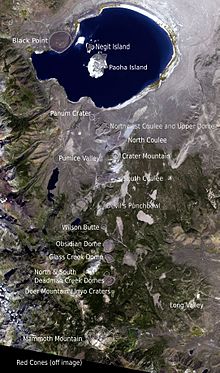User:Abyssal/Portal:Cenozoic
IntroductionThe Cenozoic (/ˌsiːnəˈzoʊ.ɪk, ˌsɛn-/ SEE-nə-ZOH-ik, SEN-ə-; lit. 'new life') is Earth's current geological era, representing the last 66 million years of Earth's history. It is characterised by the dominance of mammals, birds, and angiosperms (flowering plants). It is the latest of three geological eras, preceded by the Mesozoic and Paleozoic. The Cenozoic started with the Cretaceous–Paleogene extinction event, when many species, including the non-avian dinosaurs, became extinct in an event attributed by most experts to the impact of a large asteroid or other celestial body, the Chicxulub impactor. The Cenozoic is also known as the Age of Mammals because the terrestrial animals that dominated both hemispheres were mammals – the eutherians (placentals) in the northern hemisphere and the metatherians (marsupials, now mainly restricted to Australia and to some extent South America) in the southern hemisphere. The extinction of many groups allowed mammals and birds to greatly diversify so that large mammals and birds dominated life on Earth. The continents also moved into their current positions during this era. The climate during the early Cenozoic was warmer than today, particularly during the Paleocene–Eocene Thermal Maximum. However, the Eocene to Oligocene transition and the Quaternary glaciation dried and cooled Earth. (Full article...) Selected article on the Cenozoic world and its legaciesThe Mono–Inyo Craters are a volcanic chain of craters, domes and lava flows in Mono County, Eastern California. The chain stretches 25 miles (40 km) from the northwest shore of Mono Lake to the south of Mammoth Mountain. The Mono Lake Volcanic Field forms the northernmost part of the chain and consists of two volcanic islands in the lake and one cinder cone volcano on its northwest shore. Most of the Mono Craters, which make up the bulk of the northern part of the Mono–Inyo chain, are phreatic (steam explosion) volcanoes that have since been either plugged or over-topped by rhyolite domes and lava flows. The Inyo volcanic chain form much of the southern part of the chain and consist of phreatic explosion pits, and rhyolitic lava flows and domes. The southernmost part of the chain consists of fumaroles and explosion pits on Mammoth Mountain and a set of cinder cones south of the mountain; the latter are called the Red Cones. Eruptions along the narrow fissure system under the chain began in the west moat of Long Valley Caldera 400,000 to 60,000 years ago. Mammoth Mountain was formed during this period. Multiple eruptions from 40,000 to 600 years ago created the Mono Craters and eruptions 5,000 to 500 years ago formed the Inyo volcanic chain. Lava flows 5,000 years ago built the Red Cones, and explosion pits on Mammoth Mountain were excavated in the last 1,000 years. Uplift of Paoha Island in Mono Lake about 250 years ago is the most recent activity. These eruptions most likely originated from small magma bodies rather than from a single, large magma chamber like the one that produced the massive Long Valley Caldera eruption 760,000 years ago. During the past 3,000 years, eruptions have occurred every 250 to 700 years. In 1980, a series of earthquakes and uplift within and south of Long Valley Caldera indicated renewed activity in the area. The region has been used by humans for centuries. Obsidian was collected by Mono Paiutes for making sharp tools and arrow points. Glassy rock continues to be removed in modern times for use as commercial scour and yard decoration. Mono Mills processed timber felled on or near the volcanoes for the nearby boomtown Bodie in the late 19th to early 20th centuries. Water diversions into the Los Angeles Aqueduct system from their natural outlets in Mono Lake started in 1941 after a water tunnel was cut under the Mono Craters. Mono Lake Volcanic Field and a large part of the Mono Craters gained some protection under Mono Basin National Forest Scenic Area in 1984. Resource use along all of the chain is managed by the United States Forest Service as part of Inyo National Forest. Various activities are possible along the chain, including hiking, bird watching, canoeing, skiing, and mountain biking. (Full article...) Selected article on the Cenozoic in human science, culture and economicsEdward Drinker Cope (July 28, 1840 – April 12, 1897) was an American zoologist, paleontologist, comparative anatomist, herpetologist, and ichthyologist. Born to a wealthy Quaker family, he distinguished himself as a child prodigy interested in science, publishing his first scientific paper at the age of 19. Though his father tried to raise Cope as a gentleman farmer, he eventually acquiesced to his son's scientific aspirations. Cope had little formal scientific training, and he eschewed a teaching position for field work. He made regular trips to the American West, prospecting in the 1870s and 1880s, often as a member of U.S. Geological Survey teams. A personal feud between Cope and paleontologist Othniel Charles Marsh led to a period of intense fossil-finding competition now known as the Bone Wars. Cope's financial fortunes soured after failed mining ventures in the 1880s, forcing him to sell off much of his fossil collection. He experienced a resurgence in his career toward the end of his life before dying on April 12, 1897. Though Cope's scientific pursuits nearly bankrupted him, his contributions helped to define the field of American paleontology. He was a prodigious writer with 1,400 papers published over his lifetime, although his rivals debated the accuracy of his rapidly published works. He discovered, described, and named more than 1,000 vertebrate species, including hundreds of fishes and dozens of dinosaurs. His proposal for the origin of mammalian molars is notable among his theoretical contributions. (Full article...) Selected imagesNeed help?Do you have a question about Abyssal/Portal:Cenozoic that you can't find the answer to? Consider asking it at the Wikipedia reference desk. TopicsGeochronology - Paleogene (Paleocene - Eocene - Oligocene) - Neogene (Miocene - Pliocene) - Quaternary (Pleistocene - Holocene) Cenozoic landmasses - Major Cenozoic events - Paleogene biota appearances - Neogene biota appearances - Quaternary biota appearances - Fossil sites - Stratigraphic units - History - History of paleontology - Timeline of paleontology Researchers - Culture - Treatise on Invertebrate Paleontology - Vertebrate Paleontology Quality ContentFeatured Cenozoic articles - Good Cenozoic articles - History of paleontology - Evolutionary history of life SubcategoriesRelated contentAssociated WikimediaThe following Wikimedia Foundation sister projects provide more on this subject:
|


































